
And so we come to part two of the Georgia trip, waking up early on Jekyll Island. I’ve been planning this one since the last trip, three years ago. So sit back and get comfy while I take you directly out there.
Walkabout podcast – Out at sunrise
This Google Earth placemark will take you right to the shooting locale of my images here (provided you have Google Earth installed on your system.) While this one will take you all the way down to Negritos, Ecuador, and a lighthouse at the westernmost point of South America which is, nevertheless, still east of Jekyll Island.
 I’ve mentioned this before but will say it again: for sunrise and sunset shots, bracketing the exposure heavily is highly recommended, and by this I mean, taking several frames both over and under exposed from what the camera’s exposure meter is reading; this page may help you to understand it better. The sky colors may appear significantly different depending on the exposure, and you will likely find that the best results come from a setting other than what the exposure meter would produce by itself. And, as I stress in the podcast, your white balance should be set only to Daylight.
I’ve mentioned this before but will say it again: for sunrise and sunset shots, bracketing the exposure heavily is highly recommended, and by this I mean, taking several frames both over and under exposed from what the camera’s exposure meter is reading; this page may help you to understand it better. The sky colors may appear significantly different depending on the exposure, and you will likely find that the best results come from a setting other than what the exposure meter would produce by itself. And, as I stress in the podcast, your white balance should be set only to Daylight.
Most of the trunks on this beach sit just within the high tide line, so being there after the tide receded, and before anyone had any chance to introduce their own footprints, meant the beach was smooth and clean, much more pleasing to the eye for compositions like this. And this means that it’s fairly important to plan out your images before you put your own footprints into the shot (this is, unsurprisingly, much more important with things like snow.) This day, the sand was still slightly damp, not having been dried by the sun yet, and going barefoot meant that I was even less likely to leave behind noticeable footprints; what I did leave, when they were noticeable at all, looked a lot more appropriate to such scenes than the sandal prints. Just a little forethought.
Locations and conditions like this provide a lot of options for compositions, and it’s easy to frame dozens of different approaches in the space of a few minutes. Be warned, though, that the colors change faster than you might imagine, so you may still have to be on your toes when the sky produces something really dramatic. If you’ve waited until you see the conditions in the opening photo before finding a good foreground, for instance, you’re probably going to miss the shot. Be ready ahead of time, have all the camera settings where you want them (including contrast and saturation,) and know how to change them quickly if you decide that the shots will benefit from higher saturation or a lower ISO. And a tripod isn’t a bad idea.

As I looked out across the sound, the light at St Simon’s lighthouse had been extinguished, but the glass panels surrounding it were still positioned right to produce sharp reflections from the low sun.
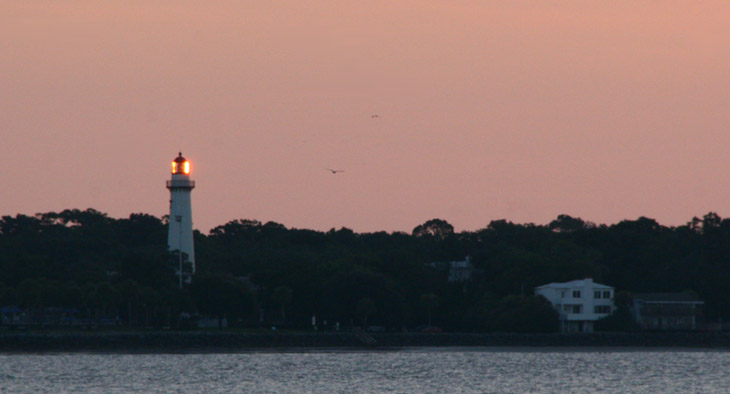
I would have liked the birds in the shot to be a little more prominent, but ya take whatcha get, and the background sky was a nicely moody hue. I was a little too west of the lighthouse to catch any of the sunlight colors on the tower itself but, you know, there’s always next time.
I mention how good this time of day is for portraiture, and I present to you an example, a self-portrait taken without the use of a smutphone or selfie-stick, just a timer. I was the only one around, so that’s who I had to work with, but even that wasn’t quite enough to ruin the shot. Note the color cast visible on everything that the sun was shining upon. And yes, I detoured well to the side to keep footprints out of the foreground, approaching from behind my sitting position. Forethought.

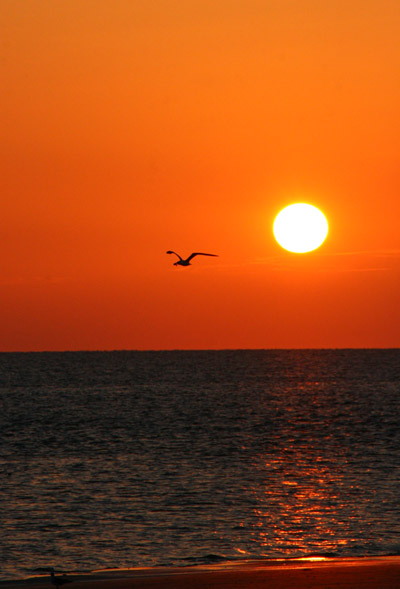 I did manage to get a little more cooperation from the birds as the morning progressed, but not as many frames as I would have liked. When a bird is flapping, only certain wing positions (like this one) look good in the air, but timing the shot to catch the wings right there is next to impossible. Or at the very least, beyond my present abilities. So while I was firing off a lot of frames in the hopes of capturing more than a few with a photogenic angle, a lot fewer of them actually showed this than I thought they might. Most especially, don’t just hold the shutter down and let the frame-per-second rate of the camera do the work, since it’s entirely possible that it runs at the same rate as the flapping (or any other repetitive action) and you just get a sequence of the exact same pose. Be sure to pause, and if you have something flapping slower, try to time the shot precisely.
I did manage to get a little more cooperation from the birds as the morning progressed, but not as many frames as I would have liked. When a bird is flapping, only certain wing positions (like this one) look good in the air, but timing the shot to catch the wings right there is next to impossible. Or at the very least, beyond my present abilities. So while I was firing off a lot of frames in the hopes of capturing more than a few with a photogenic angle, a lot fewer of them actually showed this than I thought they might. Most especially, don’t just hold the shutter down and let the frame-per-second rate of the camera do the work, since it’s entirely possible that it runs at the same rate as the flapping (or any other repetitive action) and you just get a sequence of the exact same pose. Be sure to pause, and if you have something flapping slower, try to time the shot precisely.
By the way, subjects like this often benefit from shooting a little wider, a shorter focal length than ‘good composition’ might dictate. The reason for this is, as the bird tracks sideways, the elements in the frame are changing, and being able to nail the bird with some leading space ahead of it, and the sun and the water and the glitter trail, even the beachline, all precisely where you want them in the frame in the fraction of a second is, to say the least, demanding. So shoot a little wider, leaving more space around everything, then crop it down to your desired effect.
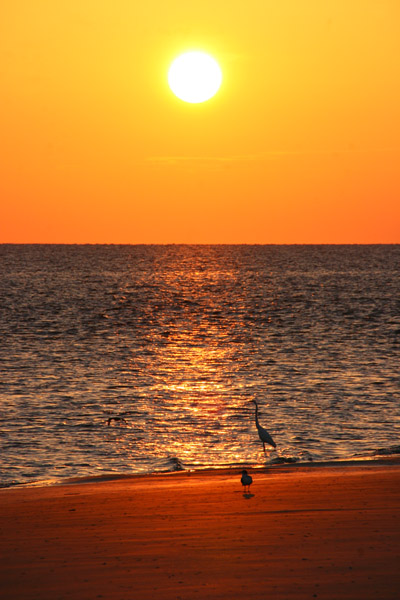 This image was taken only three minutes after the previous, so the conditions were not significantly lighter, but the framing was slightly different, producing a different exposure and rendition of the colors. The unfortunate part of this was the high contrast nature of the water texture, disguising the egret’s beak and almost completely hiding the one tern in the air in front of the egret (did you see it?) Naturally, I wasn’t aware of how this would look until I had unloaded the memory card at home, and by then I was a couple of days and five hundred kilometers too late to do anything about it. Notice, though, the illustration of a trait I’d mentioned in the previous podcast, the lack of any waves or breakers. This might have been the timing of the tides – you can see some faint waves from the visit three years ago – but for the most part the surf off of Jekyll appears to be pretty calm. Good for some things, but not as dramatic for photos.
This image was taken only three minutes after the previous, so the conditions were not significantly lighter, but the framing was slightly different, producing a different exposure and rendition of the colors. The unfortunate part of this was the high contrast nature of the water texture, disguising the egret’s beak and almost completely hiding the one tern in the air in front of the egret (did you see it?) Naturally, I wasn’t aware of how this would look until I had unloaded the memory card at home, and by then I was a couple of days and five hundred kilometers too late to do anything about it. Notice, though, the illustration of a trait I’d mentioned in the previous podcast, the lack of any waves or breakers. This might have been the timing of the tides – you can see some faint waves from the visit three years ago – but for the most part the surf off of Jekyll appears to be pretty calm. Good for some things, but not as dramatic for photos.

I’m going a bit out of order with this one, since it was shot earlier than all but the predawn image that opened the post. Shining my flashlight on a whim into a crevice within a large trunk, I found this crab feasting merrily on a fish head that had been brought in and left by the tides. Fishing boats drop a lot of chum into the water as bait just off the coast here, and lots of species take advantage of it. I’m not sure, but I suspect this is a purple marsh crab (Sesarma reticulatum.) The direct flash angle didn’t help at all, letting the complicated details all blend together too much, but there was no other way I was going to light the scene within the crevice.
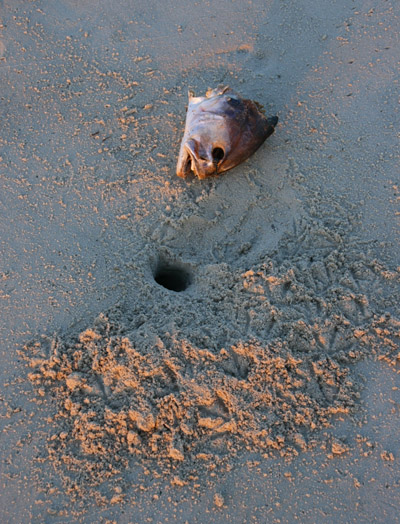 This is a little bit different story. I’d initially shot this with a flash too, before the sun was up, but returned to it afterwards to take advantage of natural light, which did a vastly better job of rendering the scene. I have little doubt that the large crab who made that burrow did not just happen to find a fish head on its doorstep, but chose to make a new burrow where a lasting meal would be handy. At least until the seabirds made off with it – you can see the footprints of the first marauder in the fresh sand. Again, note the low light angle and the color cast, something that also worked well for the month-end abstract for August. If you want texture details, sidelighting is the key, and a low sun is excellent for providing that. But if you can’t use the sun, then an off-camera flash unit can do the trick too, and will usually provide a lot more angle options.
This is a little bit different story. I’d initially shot this with a flash too, before the sun was up, but returned to it afterwards to take advantage of natural light, which did a vastly better job of rendering the scene. I have little doubt that the large crab who made that burrow did not just happen to find a fish head on its doorstep, but chose to make a new burrow where a lasting meal would be handy. At least until the seabirds made off with it – you can see the footprints of the first marauder in the fresh sand. Again, note the low light angle and the color cast, something that also worked well for the month-end abstract for August. If you want texture details, sidelighting is the key, and a low sun is excellent for providing that. But if you can’t use the sun, then an off-camera flash unit can do the trick too, and will usually provide a lot more angle options.

This is another view of the same crab seen earlier as a teaser, with a different scale aspect – those are sand grains sitting atop the carapace. I should have fired off the flash to fill in for those shadow areas left by the sunlight, but I honestly didn’t think to – I suspect I thought that the reflection from the sand would have been sufficient. Either way, I failed, and it could have been better, but for a quick shot snagged before the crab could scamper off, I’m not going to complain too much. Without the ability to corral it within a certain area, I had only a slim opportunity to even get this close before I would lose the subject. Next time, I’ll bring a shallow tray to set up a natural-looking surface and do some nice detail shots of the crabs I can capture.
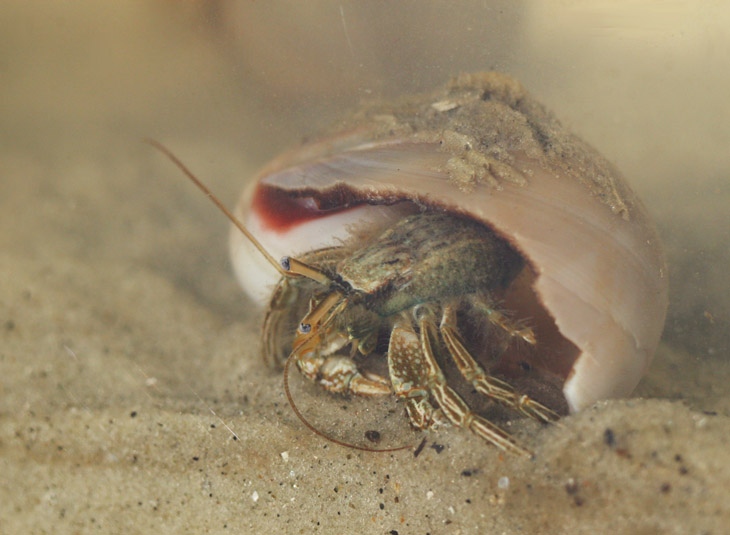
I’m going to tentatively identify this one as a thinstripe hermit crab (Clibanarius vittatus,) since it looks a lot like the ones I used to find in Florida, even though one source doesn’t peg them as appearing by the barrier islands of Georgia – feel free to correct me, anyone with good info. This is one of the ones that inadvertently rode back to the motel room in my pocket, and so got to be photographed in the macro aquarium later that morning.
As the day wore on, we’d traveled back to the Savannah area and visited the Savannah National Wildlife Refuge (I keep calling it the Savannah River refuge, but that’s not the correct title,) the place where I’d gotten several pleasing alligator shots, one of which is visible in the rotating header images if you wait long enough or are lucky. This time around, there was almost nothing to be seen, but I did capture an eastern lubber grasshopper (Romalea microptera,) which The Girlfriend’s Younger Sprog shot on my hand with her phone – I, obviously, was unable to wield a camera to do my own photos.
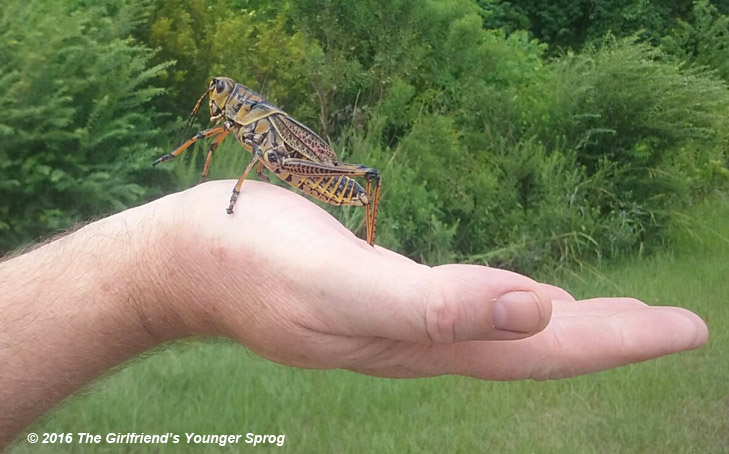
Curiously, while perched initially on my hand without being restrained, it chose to start biting me, but why this might be I haven’t the faintest. I flinched reflexively, just from the size of the thing, but there really wasn’t the slightest danger from those mouthparts.
Later that evening, I went exploring around Our Hosts’ property again to see what could be found. The first was this green anole (Anolis carolinensis) snoozing on a tree branch, which was good because it took about 15 minutes before the camera lens was warm enough not to fog up in the rainforest conditions, after sitting in the air conditioning for too long.

 I think the little guy at right is a bird-voiced treefrog (Hyla avivoca,) but the variety of photos and markings that I’ve seen for that species make this tentative at best – it’s the closest I can come to pinning down an ID, anyway. It wasn’t calling when I spotted it, so that avenue of confirmation wasn’t open to me.
I think the little guy at right is a bird-voiced treefrog (Hyla avivoca,) but the variety of photos and markings that I’ve seen for that species make this tentative at best – it’s the closest I can come to pinning down an ID, anyway. It wasn’t calling when I spotted it, so that avenue of confirmation wasn’t open to me.
However, what I was really after, besides my continuing quest for scorpions, was a cottonmouth, sometimes called a water moccasin, but the number of species that are called ‘moccasins’ is wide and varied, so we’ll go with the scientific name of Agkistrodon piscivorus, and you’re on your own regarding that pronunciation. I failed to see one, but I did see three other snakes of two different species, so I can’t consider the night a failure.
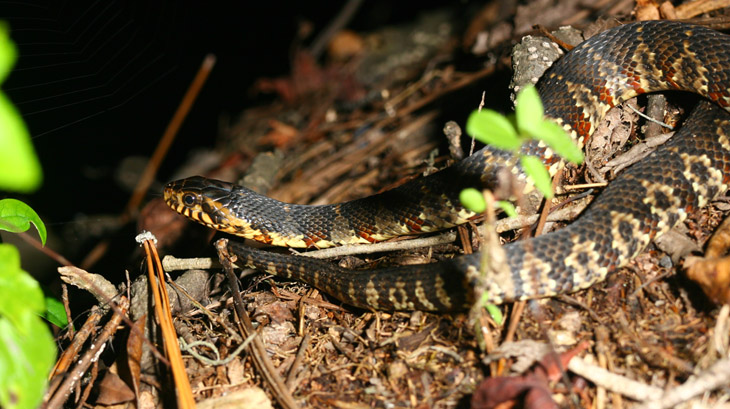 The specimen above had me suspect that I’d finally found one, until I carefully leaned in a little closer and could see the markings better; instead, this is a southern banded water snake (Nerodia fasciata,) and completely harmless, despite having the same habitat and behavior as a cottonmouth, save for the open-mouth threat display that the latter has at times (which is where it gets its name.) This is a small one, less than 40 cm long and perhaps slightly larger in diameter than my thumb, and while the headlamp confused it, it was starting to get suspicious after a minute or two and slowly slipped off into the undergrowth.
The specimen above had me suspect that I’d finally found one, until I carefully leaned in a little closer and could see the markings better; instead, this is a southern banded water snake (Nerodia fasciata,) and completely harmless, despite having the same habitat and behavior as a cottonmouth, save for the open-mouth threat display that the latter has at times (which is where it gets its name.) This is a small one, less than 40 cm long and perhaps slightly larger in diameter than my thumb, and while the headlamp confused it, it was starting to get suspicious after a minute or two and slowly slipped off into the undergrowth.
Not far away I found another, the second specimen of this species seen that evening – the first had slipped into the water before I brought the camera to bear, and the resulting photo of it was sufficient only for a positive ID and not for blog use. Below is a northern water snake (Nerodia sipedon,) seen a few times elsewhere on this blog.
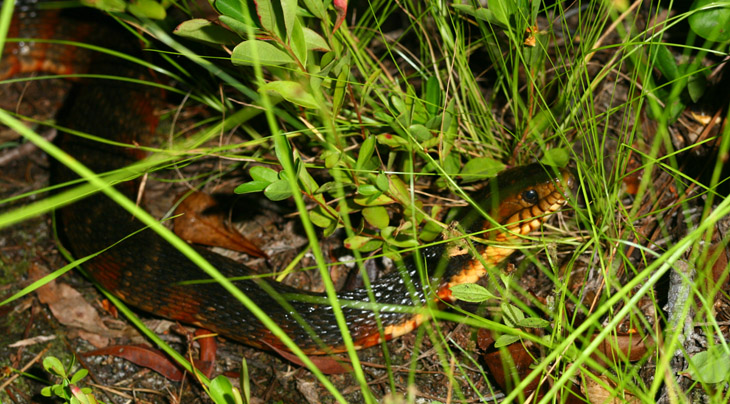
This one was a massive specimen, about as thick as my wrist in the midsection, and had just emerged from the water and so was still glistening – snakes look so much more vibrant in color when wet. You can tell from the raised head that this one was also suspicious, though the bright headlamp kept it from knowing exactly how close I was to it. This species usually does not hesitate to bite when they feel threatened, but the provocation mostly requires actual contact or at least being within a handspan distance, and I was slightly more than that (probably about a meter, to be honest.) It was funny, because I was distinctly searching for a venomous snake, and each time I spotted one there was a quick thrill, dismissed when I found out I was facing a harmless species (granted, someone else’s definition of ‘harmless’ might be different from mine, but I’ve been bitten more times than I can count.) I also need to note that a handful of frog and snake pics would normally be considered a decent night’s work, but there are over 530 frames between the first image in this post and this one, so that’s a damn good haul for a day. How many of them are true keepers? Well, a lot less, but still…
And I close with a photo from Our Female Host, for reasons unknown shooting the same sunrise on the beach by the motel room (a few kilometers away from where I was) with her goddamn smutphone. Given that, it’s a pretty good shot anyway – it just could have been better…





















































